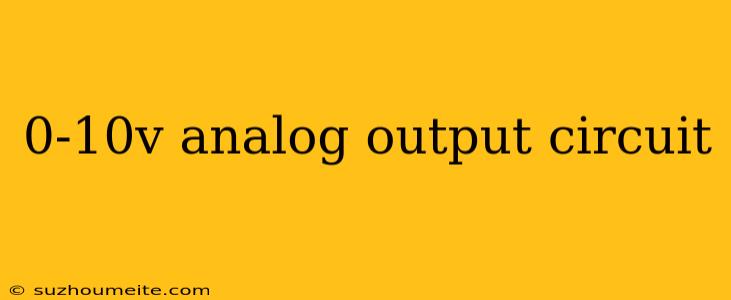0-10V Analog Output Circuit: A Comprehensive Guide
Introduction
Analog output circuits play a crucial role in various industrial and commercial applications, including process control, automation, and instrumentation. One of the most common types of analog output circuits is the 0-10V analog output circuit, which is widely used in applications that require a voltage output signal in the range of 0 to 10 volts.
In this article, we will explore the basics of 0-10V analog output circuits, their working principle, and the various applications of these circuits.
What is a 0-10V Analog Output Circuit?
A 0-10V analog output circuit is an electronic circuit that produces a voltage output signal in the range of 0 to 10 volts. This type of circuit is commonly used in industrial control systems, where a specific voltage level is required to control a valve, motor, or other devices.
The 0-10V analog output circuit typically consists of a power supply, an amplifier, and a voltage regulator. The power supply provides the required voltage to the circuit, while the amplifier boosts the output voltage to the desired level. The voltage regulator ensures that the output voltage remains stable and within the specified range.
Working Principle of 0-10V Analog Output Circuit
The working principle of a 0-10V analog output circuit is based on the concept of voltage amplification. The circuit amplifies a low-level input signal to produce a high-level output voltage in the range of 0 to 10 volts.
The process can be divided into three stages:
Stage 1: Input Stage
The input stage consists of a sensor or transducer that converts the physical parameter (such as temperature, pressure, or flow rate) into an electrical signal. This signal is typically a low-level voltage signal.
Stage 2: Amplification Stage
The amplification stage consists of an amplifier that boosts the low-level input signal to a higher level. The amplifier gain is adjusted to produce the desired output voltage range.
Stage 3: Output Stage
The output stage consists of a voltage regulator that ensures the output voltage remains stable and within the specified range of 0 to 10 volts.
Applications of 0-10V Analog Output Circuits
0-10V analog output circuits have a wide range of applications in various industries, including:
- Process Control: 0-10V analog output circuits are used to control valves, pumps, and other devices in process control systems.
- Industrial Automation: These circuits are used in industrial automation systems to control motors, actuators, and other devices.
- Instrumentation: 0-10V analog output circuits are used in instrumentation systems to measure and control physical parameters such as temperature, pressure, and flow rate.
- Medical Devices: These circuits are used in medical devices such as ventilators, dialysis machines, and infusion pumps.
Advantages of 0-10V Analog Output Circuits
0-10V analog output circuits offer several advantages, including:
- High Accuracy: These circuits provide high accuracy and stability, making them suitable for critical applications.
- Flexibility: 0-10V analog output circuits can be customized to meet specific application requirements.
- Reliability: These circuits are highly reliable and can operate in harsh industrial environments.
Conclusion
In conclusion, 0-10V analog output circuits play a vital role in various industrial and commercial applications. These circuits offer high accuracy, flexibility, and reliability, making them an essential component in process control, industrial automation, instrumentation, and medical devices. By understanding the working principle and applications of 0-10V analog output circuits, engineers and technicians can design and implement these circuits effectively in their respective applications.
